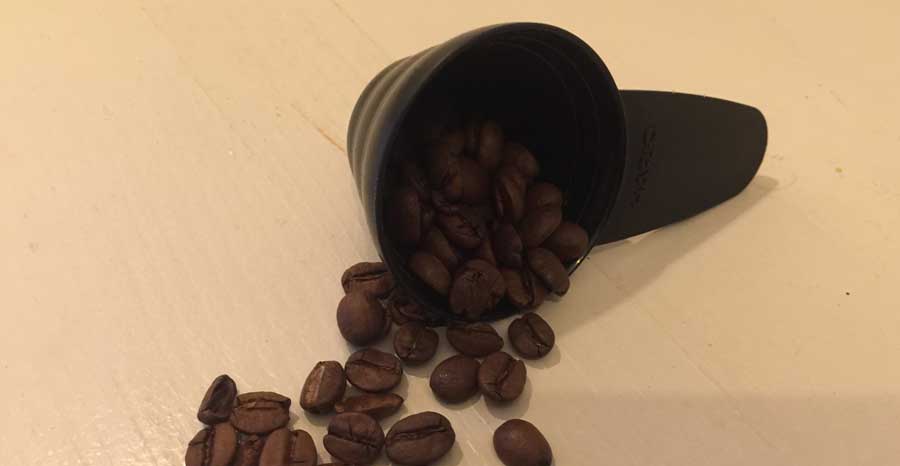Knowing how much coffee to brew is not as straightforward as it could be. A person might know how to make their personal dose of coffee in the morning, but when visitors come over and they need to make ten or twelve cups in the pot, they need some help with the math. If you are using metric measurements, this is a breeze! For English-style measurements, check out this other post.
Coffee by Cup
| Brewing Ratio (The Metric Way) | ||
| Cups to Brew | How Much Coffee | How Much Water |
| 1 | 11 grams | 200 ml |
| 2 | 22 grams | 400 ml |
| 4 | 44 grams | 800 ml |
| 6 | 66 grams | 1.2 liters |
| 8 | 88 grams | 1.6 liters |
| 10 | 110 grams | 2 liters |
| 12 | 132 grams | 2.4 liters |
The “Golden Ratio” is 55 grams of coffee for every liter of water. According to the Specialty Coffee Association this will give you an acceptable cup of coffee. It is up to you to adjust your water to fit your cup needs and your ground coffee to fit your tastes. But that is just the beginning; if you really want to geek it up, I have some easy tips for you.
Coffee by cup chart
What is the correct amount of water?
Better Measuring
What is the correct amount of coffee?
Coffee by volume chart
What is the correct amount of water?
The first thing you might notice is that the table above says you are brewing 1 cup of coffee. Here is where some confusion may arise. A “cup” can mean different things depending on the circumstances. A cup of water by US measure is 8 fluid ounces. This is equal to about 237 ml. But wait a minute: A “cup” of coffee is 6 fluid ounces, about 177 ml. The reason for this discrepancy is because coffee is usually served in a “teacup” and a teacup traditionally holds six ounces. Now, if like me you like your coffee in a mug, that is usually going to come in at 300 – 350 ml depending on the size. A Starbucks Venti? Well, venti is the Italian word for twenty and 20 fluid ounces equals 600 ml.
FYI
Those little cups they serve you in a fancy restaurant are called a demitasse. Demitasse comes from the French words demi and

Wow… Deja vu!
Get the measurement right
Obviously, there is a large variation in the amount of liquid that might be found in a “cup.” To get our brewing ratio correct we must accurately determine how much water we are actually dealing with. That means we are going to have to break out a measuring cup to find nail down our numbers.
- What is the volume of your cup?
- What is the volume of your pot?
- Those gradations on your pot? What are they measuring?

Swiped from HulaDaddy.com
I know, the pot says “12,” but 12 what? 12 teacups or 12 US cups? Is it 12 restaurant size cups? Or maybe it is just 12 of whatever the guy who designed the pot had laying around. The bottom line
What is the correct amount of coffee?

a scoop is little more than a guess.
Using a volume measure like “spoonfuls” or “scoops” is not an accurate way to determine how much coffee you have. Beethoven is known to have insisted on 60 beans for each cup of coffee. Is that any better? Both of these methods fail to account for the fact that some coffees are less dense than others and all coffee beans are not the same size. “Two spoonfuls per cup” or “10 scoops per pot” is just not going to get the job done. If you want the right amount of coffee you must weigh it.
Remember, the “golden ratio brew” is 55 grams per liter of water. Which means that if you are brewing one of my 350 ml mugs in a pour over, you will need to use xx grams of coffee for the proper brew. So, break out the kitchen scale if you really want to get it right.
Brewing Ratio By Volume
| Brewing Ratio (By Volume) | ||
| Cup Size | How Much Coffee to Use | Water |
| Demitasse (90 ml) | 5 grams | 90 ml |
| Teacup (180 ml) | 10 grams | 180 ml |
| 200 ml | 11 grams | 200 ml |
| US cup (240 ml) | 13.2 grams | 240 ml |
| 300 ml | 16.5 grams | 300 ml |
| 350 ml | 19.25 grams | 350 ml |
| 1 liter pot | 55 grams | 1 liter |
Basically, just multiply the amount of water (in ml) you are using by .055 to get the proper amount of coffee.
Of course, in the end, it is all a matter of taste. Brew a cup and see if it is all you hoped it would be. If it isn’t, then adjust the amount of coffee up or down to suit your taste. Once you have zeroed in on your brewing preferences, you can go back to the “spoonful” method. You will be able to estimate accurately how much coffee you need for your particular situation. I suggest checking your measurements when you switch coffees; every coffee is different from roast to roast and switching from a Sumatran Monsooned coffee to a strictly hard bean Guatemalan might make a big difference in the amount of coffee you need for a specific volume. A little time and care can go a long way toward improving your cup.
Coffee by cup chart
What is the correct amount of water?
Better Measuring
What is the correct amount of coffee?
Coffee by volume chart

